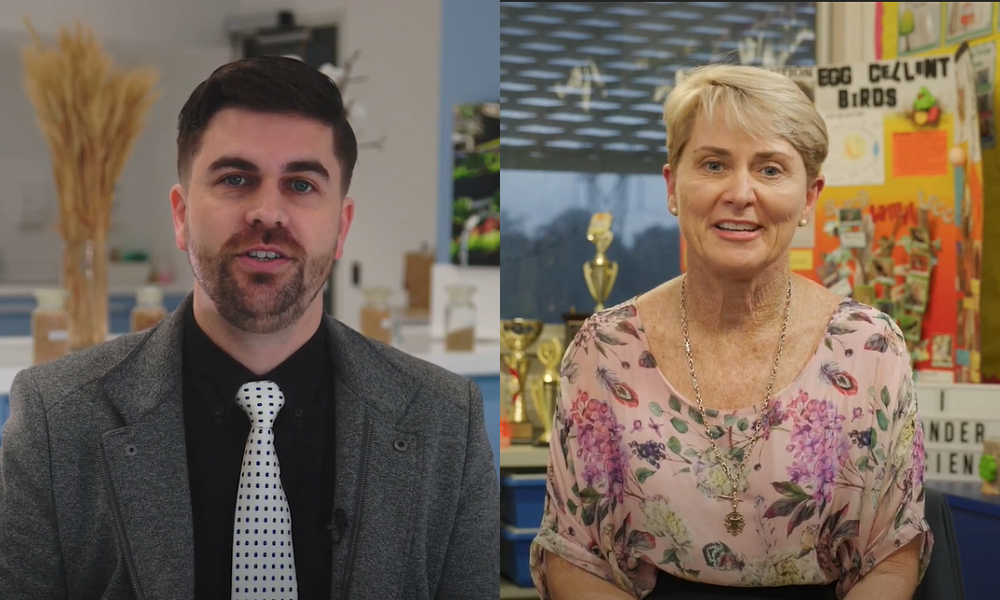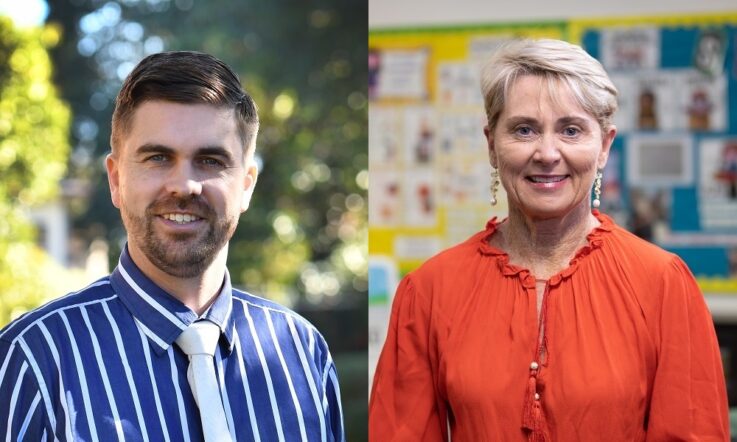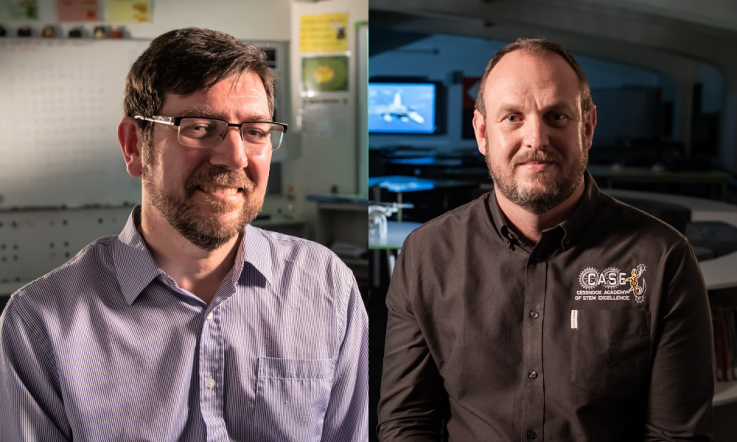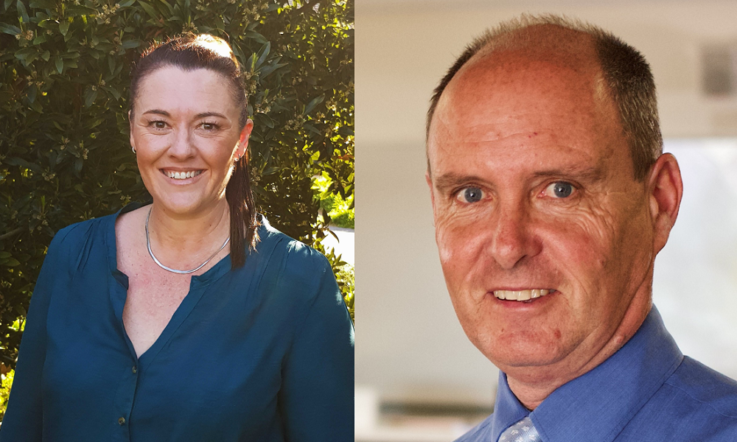Thanks for downloading this podcast from Teacher magazine. I’m Dominique Russell.
Each year, two educators in Australia are named winners of the Prime Minister’s Prize for Excellence in Science Teaching – one primary school teacher, and one secondary school teacher. For 2021, the primary school teacher named winner was Megan Hayes from Mudgeeraba Creek State School in Queensland, and Scott Graham from Barker College in Sydney was the recipient for the secondary teacher award.
Both have gone above and beyond to improve student outcomes in science in their school settings. For Megan, this has meant focusing on supporting more girls to get involved and engaged in STEM, while Scott has worked over the years to foster an appreciation and interest in the study of agriculture.
I caught up with both Megan and Scott late last year to find out a little bit more about the work they’re doing in the classroom and in their wider school community. We’re bringing you these conversations in this episode. Let’s hear from Scott first.
Scott Graham: So, Barker College is a 130-year-old school on the North Shore of Sydney, and we have around about 2700 students from K-12. We have around about 60 boarders as well, in senior years, (from Years 10-12) some are from rural areas; some are from the city. And so effectively all of our students at Barker are North Shore or Northern Beaches students. They’ve grown up in that environment, in that kind of urban environment. Yeah, about as urban as it gets in Australia.
Dominique Russell: That’s such a large school – can you tell me about what your science department looks like there?
SG: Yeah, so science is very large at Barker. We have, in our senior years (Year 11 and 12) we have about 360 students in each year group and there’s around about 550 science enrolments in that year group, that includes agriculture.
So, you’re looking at around about 1.7, or something like that that, 1.8 sciences on average that students are doing. Obviously, some doing none (not many) but some doing one, some doing two, some of course doing three. So yeah, it’s quite a high science enrolment across the board.
DR: Can you share why it’s so important for you and your colleagues to emphasise the importance of the agricultural industry? Like you say, in an urban setting it’s not something you typically hear about that often, about teachers being so focused on agriculture.
SG: Yeah, so I guess the key issue is that, in Australia we have about 4-5 jobs per graduate out of agriculture degrees at university. And so there’s a massive undersupply, and at the same time there is a historical low of students in school doing agriculture in Year 12. So there’s around 2300 doing a Year 12 leaving exam in Australia for agriculture. So only 2300 or so each year; of that, about 1400 of those are in New South Wales and we have 90 of them.
So there’s a significant shortage of people in agriculture. And agriculture is fundamentally important, I like to say it’s too big to fail. Obviously, we need agriculture for our continued survival and it’s of foremost importance. It’s the reason that we can be such an urbanised country – I mean, one of the most urbanised countries in the world – is because not everyone has to grow their own food, basically. So, our agriculture is efficient and is world class.
And so with agriculture, I guess now and particularly into the future, I mean the students that are sitting in our classes are going to still be working in 30- or 40-years’ time, so we need to really be setting their sights on that.
And as a secondary point, I think students are really interested in making a difference in the world and being a part of something much bigger than themselves. And so I think agriculture really fits the bill there in terms of a lot of our students are really excited and interested about things like food security and climate change and obviously agriculture is the biggest land user in the world. About 50-60 per cent [of land] in Australia is used for agriculture. Agriculture has such a large influence over, obviously, food security but climate change as well. So, students are really interested in doing something in agriculture for that reason. And yeah, urban students in particular.
DR: Is agriculture something students are introduced to in their earlier years at Barker College, or is it something that they’re introduced to later?
SG: So as a subject that they can choose, they can only do it in Year 9-12 and it’s voluntary all the way. However in New South Wales now, agriculture’s mandatory in Year 7 and 8 technology, what’s called tech-mandatory. It’s one of the rotations that they do, one of the five rotations. And food tech … and how that’s implemented at each school is a little bit different based on their own resources. But that’s now mandatory, as of the last three years.
And so that’s really important in terms of getting them thinking about agriculture – I mean they’re all interested in it and this is the thing that people, I think people have the wrong perception about, is that urban people are super interested in agriculture and the paddock-to-plate kind of thing and they actually want to know about it, but are kind of structurally separated from agriculture. That’s just the way our society works, but they don’t necessarily want to be.
And so students in Year 8 – we do it in Year 8 in the mandatory tech unit, agriculture component – and so students really enjoy that. And parents, they come to the Year 9 curriculum night where they get to choose their subjects and the parents are like ‘man, I wish we could do this, I wish we could sign up or go on this trip or go on this excursion. I wish we had this when I was at school’. So there’s such an interest there.
And then further than that, we like to get the junior school involved a lot. One of our agriculture teachers is our STEM (or at Barker we call it STEAM, with Arts as well) and she’s our STEAM coordinator, and so she uses part of that time with the junior school to take the junior school students to – we’ve got four baby calves at the moment that we’re feeding twice a day with milk for a couple of weeks – so we’ve take them down there and we’re just introducing … there’s various other things like BEAT team in junior school, which is the Barker Environmental Action Team. So they grow veggies and that kind of things down there in the junior school which is on the same campus but slightly removed. We’re trying to get them involved from Kindergarten.
I guess what we’ve called it is we’re trying to ‘normalise’ ag, because agriculture, typically in most places where it’s taught, is kind of like the ag plot is the farm, is kind of down the back out of the way. And the kids who don’t do ag (which is not many of them doing ag generally across the state as a percentage of school cohorts) they don’t know anything about it, they don’t see it, it’s not part of their life.
So we like to have, like we’ve got our veggie gardens and stuff and veggie pods on the roof of the Science building, and they’re all kind of dispersed around the school and so students walk past them or, you know, they get to see things. We’re trying to normalise agriculture. So, trying to make it a part of their normal, everyday life and not an extra thing that someone else does out the back in the bush somewhere. But it’s part of our lives and they’re involved in it. So absolutely we try to get them involved in Kindergarten and every year beyond that.
DR: For other science teachers looking to enhance their teaching in agriculture, what are some good first steps or some things to keep in mind?
SG: So I think there’s probably two things I’d say. One’s about strategy and one’s about resources. So to get the resources out of the way I guess, first, the Primary Industry’s Education Foundation of Australia (which is P-I-E-F-A or PIEFA), they have a website resource called Prime Zone. And so, if people search on Google for ‘Prime Zone’ it’s the first one that will come up.
And it’s a site that has a whole load of resources for primary industries – you know, agriculture, forestry, fishing, all that kind of stuff, for all different year groups. So I’d really recommend that in terms of being a resource. And as we mentioned agriculture is now mandatory in New South Wales in Year 7 and 8 tech so a lot of teachers I think have been utilising that. And that’s applicable across the country, it’s not state-based in any way. Yeah, so that’s all free and that’s a fantastic resource.
But I think in terms of strategy, agriculture is really easy to engage students and I think because we talk about the paddock-to-plate and I think the thing that interests urban students is I think the background to why we have such large enrolments in agriculture, is that, as I mentioned, urban people are actually really interested in the paddock-to-plate.
You look at the success of cooking shows on TV and various things like that and people are really, really interested in how their food has been made and where it’s come from. The provenance, you know, where it’s come from, is now an increasingly important thing where people want to know where it’s come from and how it’s been produced and it’s a big deal. And so it’s not hard to get urban people interested in that, they’re already interested in that, it’s just tapping into that.
So my suggestion in terms of strategy would be, yes paddock-to-plate, but you need to start at the plate and work backwards to the paddock. Because I think students, they all know about the plate, like they’ve been eating their whole life and they will obviously for the rest of their life. And so my saying at our curriculum nights, for example, is that agriculture will have four or five interactions with you every day of your life. So, you know, are you going to have anything to do with agriculture? Are you going to learn anything about how things are produced and how it gets to you?
And so I think if you start from the plate and work your way backwards maybe to the paddock, that’s kind of an easier way to connect with the students because it’s stuff they already know. They’ve been eating different cuts of steak or they’ve been eating, you know, whatever it is, they know a bit about free range eggs or something. So working backwards I think is the key want to engage urban students, which in Australia is about 90 per cent of us.
That was Scott Graham there. Now it’s time to take you to Megan Hayes, STEM specialist at Mudgeeraba Creek State School. She’s passionate about getting girls involved in STEM and has even started her own conference called ‘Sistas in STEM’. Here, she explains how she was able to pull it all off, and some of her favourite learning activities in the classroom.
MH: Well Mudgeeraba Creek is located on Queensland’s Gold Coast. We’re called the green behind the gold. We’re in the semi-rural, we have 750 students here, so most year levels have four cohorts.
My role started in 2016 when we found that the interest in science and the culture of science was growing in our school quickly and it was an area that I was really interested in. And we have a very forward-thinking principal and [the principal] Diedre put out an expression of interest to the staff for someone to take on the role in a specialist position.
So I got that role and in 2016 I started with a model which had the classes coming to me with their teacher. So it was like a train the trainer type set up where the teachers were able to see what I was doing, we were able to work collaboratively, and then they went back to their classroom and they could continue on with that idea. The following year (or was it two years?) after I started, we then brought on board my colleague who is digital technology based, and we work together, side by side, that sort of thing.
So that’s where the idea grew from. And when I started there weren’t STEM specialists – if you want to call it that – type of people, especially on the Gold Coast, so it was all very new and a lot of trial and error. And my program that I currently work on with the staff and the students has evolved and changes and is a living, breathing thing.
DR: You’re passionate about getting girls involved STEM and engaged in STEM, too. So, can you talk me through how you do that and how female engagement has evolved over the years?
MH: When I first started, the first year I got the students to draw a picture of what they thought a scientist looked like and an engineer looked like. And I had, you know, 98 per cent of them were male. So I went ‘mmm, there’s a problem here’.
And so every time I get an explicit teaching moment, I show them how women are doing amazing things in the world and their effect on society and the community.
Even with my Year 1s we talk about ‘does a scientist have to be a man?’ and they [say] ‘no, no’. Yesterday I was doing a storybook with the Year 1s who’ve come for the first time in Term 3 and Term 4. And already I can see them changing their mindset. And I read a story called If I Built a House. I was telling them that there are lots of types of engineers in our world and an architect is a type of engineer because they plan and they build houses and buildings, from a skyscraper to a cottage. And I just stopped and did that ‘oh, I wonder, can an architect be a girl or a boy?’ and I was waiting for a little bit of a mixed answer, but the culture had already hit them in the face and they were like ‘yes they can Mrs Hayes, don’t you know anything?’ so that was beautiful.
I have STEM Captains at school and I have a lot of girls come and volunteer to help out in the school garden, to come in and help set things up.
And this year with the COVID pandemic we had so many times where you’d plan something and it wouldn’t happen. And it wasn’t until a few months after we came back from our lockdown – our short lockdown in comparison to everyone else – I really saw a change in some of the students and it made me think that we really needed to start connecting them again.
So, I came up with this idea of the Sistas in STEM conference – a mini conference, I thought start small. And I started looking for my connections and my friends who had experience in doing conferences. I’m a primary school teacher not a conference runner. And so I had coffee with a couple of friends and they kind of got me started on the road, and then I thought ‘right I’m going to be fearless’.
So I started contacting women who I had come across over the years and we ended up with some amazing keynotes, especially – I just did a cold message to Professor Lisa Harvey-Smith (and she is the ambassador for women in STEM in Australia) and she was amazing. She did a live link up with the girls. I had 35 Year 6 and 7 girls come to the Sistas in STEM on a Saturday and we had a keynote with Lisa Harvey-Smith, we had Dr Brad Tucker, but more importantly (sorry, Brad) we had Dr Emma Tucker, his wife. She’s a GP, her area is medicine, but she’s worked with NASA.
The girls were blown away that these two people had come so far in their careers. So it’s those role models that I use as much as I can with the girls. They went away passionate and enthused. And the emails that I received from their families – I was very humbled that a small idea grew into something quite large.
So now that the word has got out … and the teachers who actually supported me and did little breakout sessions, to professionals from Griffith University – they’re going, we’ve got to go bigger and better, give more girls the opportunity. And I’m like ‘okay, let’s do this!’
It was just amazing. And I’m very fortunate that I think my passion goes across a little bit to a lot of the staff here and I had so many staff volunteer on their day off. They just wanted to be a part of it and that, in itself, is just an amazing feeling to have.
DR: I know you’ve mentioned a couple already in our conversation, but do you have any other particular learning activities that you’ve used in the classroom that are a particular highlight for you? Could you talk me through one of them?
MH: I think my favourite task to do, or challenges to do, is when I do Storybook STEM with my younger students. Their imaginations are so amazing. There are so many beautiful books that have been published now with a 21st Century skills focus. The … if something goes wrong, solving problems, there’s so many out there.
One of my favourites is What Do You Do With an Idea? And it teachers my little ones that, you know, if you have an idea, don’t be afraid to share it. Don’t be afraid to have a go. Stand up for yourself and nurture that idea. So, at the end of it, it’s their first foray into the design process, I show them how we do a plan and we label the plan. So it’s relating to their science skills as well. And I give each class a different material so we’re building in the properties of different materials. So one class might get a paper plate, one class might get a tube. And they look at it, and they go ‘well I’m going to turn this into…’ – so it’s age appropriate but they’re using that whole planning/designing cycle. They come up with rockets, some of them do lion’s masks, they just blow me away with what they come up with.
I think my other favourite one is with my Year 6s. We have school chooks and they are a favourite because you’ll be sitting in a classroom and the chooks will go walking past. And one of the problems that we’ve had is that we’ve got three – a rooster and his two girls – and we need them to have more space and to be safe.
So, I challenged the Year 6s to plan and design a prototype of a house for a hen. So I worked with the Year 6s and we looked at … all of my planning that I do, I work with my year level cohort and we bring in what they’re doing in science into the work. So, they were doing their electrical unit in science, so they did their prototype but then they had to incorporate a circuit of some description that provided some sort of care or protection for the chooks. So they were taking what they’d done in science and putting in a real-world context.
And, you know, we had fans and air conditioning and alarms for foxes. It was really fun, but it had a purpose. And all the way through anything that I do, it is related to what they do in their science lessons and I work with the science coordinator to make sure that that’s what happens.
… People always ask me, ‘what do you do and how do you get started?’ And I just want to let people know that you’ve just got to start small and just start. You don’t have to have everything all at once. I started with nothing. I was very confused about the curriculum and how it fitted, and it took me a good 12/18 months to work out that I was focusing on the design technologies. And it was easier when my colleague came on because she focuses more on the digital, but they overlap so much.
And … I’ve been doing a lot of reading lately and I found that I was doing inquiry early on and didn’t know it was inquiry. And there’s such a place for inquiry learning across all classrooms. And STEM isn’t a subject, STEM is a way of thinking, it’s about those skills. And I think that the success of our program has been that we’ve been building on those – you know, the collaboration, and the problem solving.
That’s all for this episode. Thanks for listening. Before I let you go, I thought I’d share some details about an upcoming episode we have for you. We’ll be joined again by Monash University academics Dr Erin Leif and Russell Fox, who will be taking us through how teachers and school leaders can tackle responding to inappropriate comments made by students in the classroom and playground. So you don’t miss out, don’t forget to subscribe to our podcast channel on Spotify, Apple podcasts or SoundCloud. If you want to keep listening now, you can access the 200+ episodes already in our archive. And, while you’re there, we’d love if you could rate and review us.
Scott Graham says his experience shows secondary school students are very interested in aspects of agriculture – like the concept of paddock-to-plate. As a secondary school science teacher, think about the upcoming school year. Is there an opportunity to explore the concept of paddock-to-plate with your students?
Megan Hayes shares that she often asks her students whether they think adults working in STEM fields are male or female, and that when she first did this exercise the answer was overwhelmingly ‘male’. As a primary school teacher, reflect on whether students in your school community would respond in a similar way. How could you challenge these stereotypes?



